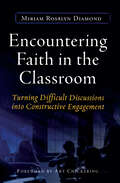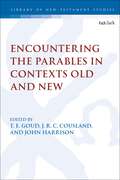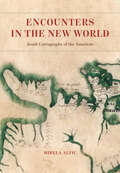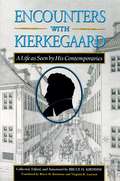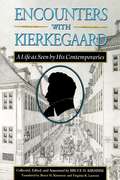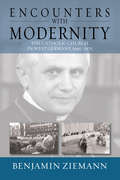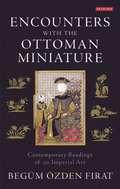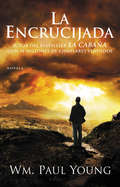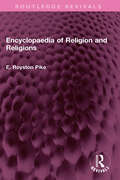- Table View
- List View
Encountering Faith in the Classroom: Turning Difficult Discussions into Constructive Engagement
by Miriam Rosalyn DiamondWhen faculty unexpectedly encounter students’ religious ideologies in the classroom, they may respond with apprehension, frustration, dread, or concern. Instructors may view this exchange as a confrontation that threatens the very heart of empirical study, and worry that this will lead to a dead-end in the learning process.The purpose of this book is to explore what happens—and what can happen—in the higher education, and even secondary school, classroom when course content meets or collides with students' religious beliefs. It also considers the impact on learning in an environment where students may feel threatened, angry, misunderstood, or in which they feel their convictions are being discredited,This is a resource that offers ways of conceptualizing, engaging with, and responding to, student beliefs. This book is divided into three sections: student views on the role of religion in the classroom; general guidelines for responding to or actively engaging religious beliefs in courses (such as legal and diversity considerations); and specific examples from a number of disciplines (including the sciences, social sciences, humanities and professional education). Professors from public, private, and religious institutions share their findings and insights.The resounding lessons of this book are the importance of creating a learning space in which students can express their beliefs, dissonance, and emotions constructively, without fear of retribution; and of establishing ground rules of respectful discussion for this process to be valuable and productive. This is an inspirational and practical guide for faculty navigating the controversial, sensitive—yet illuminating—lessons that can be learned when religion takes a seat in the classroom.
Encountering Faith in the Classroom: Turning Difficult Discussions into Constructive Engagement
When faculty unexpectedly encounter students’ religious ideologies in the classroom, they may respond with apprehension, frustration, dread, or concern. Instructors may view this exchange as a confrontation that threatens the very heart of empirical study, and worry that this will lead to a dead-end in the learning process.The purpose of this book is to explore what happens—and what can happen—in the higher education, and even secondary school, classroom when course content meets or collides with students' religious beliefs. It also considers the impact on learning in an environment where students may feel threatened, angry, misunderstood, or in which they feel their convictions are being discredited,This is a resource that offers ways of conceptualizing, engaging with, and responding to, student beliefs. This book is divided into three sections: student views on the role of religion in the classroom; general guidelines for responding to or actively engaging religious beliefs in courses (such as legal and diversity considerations); and specific examples from a number of disciplines (including the sciences, social sciences, humanities and professional education). Professors from public, private, and religious institutions share their findings and insights.The resounding lessons of this book are the importance of creating a learning space in which students can express their beliefs, dissonance, and emotions constructively, without fear of retribution; and of establishing ground rules of respectful discussion for this process to be valuable and productive. This is an inspirational and practical guide for faculty navigating the controversial, sensitive—yet illuminating—lessons that can be learned when religion takes a seat in the classroom.
Encountering Mary: From La Salette to Medjugorje
by Sandra L. Zimdars-SwartzIn the past two centuries hundreds of apparitions of the Virgin Mary have been reported, drawing crowds to the seers and the sites and constituting events of great religious significance for millions of people worldwide. Here Sandra Zimdars-Swartz provides a detective-like investigation of the experiences and interpretations of six major apparitions, including those at La Salette and Lourdes in France during the mid-nineteenth century; at Fatima, Portugal, in 1917; and the more recent ones at San Damiano, Italy; Garabandal, Spain; and Medjugorje, Yugoslavia, where the apparitions continue. Adopting a phenomenological approach to these "encounters with Mary"--one that is neither apologetic nor antagonistic--the author explores the tension between the personal meaning of the events for their subjects and the public appropriation of this meaning by a larger religious community. Along the way she examines the backgrounds of the seers, their willingness or reluctance to talk about the apparitions and their messages, the amount of emotional support they received from family and community as news of the apparitions spread, the reports of miracles at apparition sites, the reactions of local authorities, and the steps taken by the Roman Catholic Church in officially recognizing or rejecting the apparitions as worthy of belief. The author concludes with a survey of religious worldviews based on Marian apparitions, focusing especially on the now-popular transcultural apocalyptic nature of these messages to the modern world.Originally published in 1991.The Princeton Legacy Library uses the latest print-on-demand technology to again make available previously out-of-print books from the distinguished backlist of Princeton University Press. These editions preserve the original texts of these important books while presenting them in durable paperback and hardcover editions. The goal of the Princeton Legacy Library is to vastly increase access to the rich scholarly heritage found in the thousands of books published by Princeton University Press since its founding in 1905.
Encountering Medieval Textiles and Dress: Objects, Texts, Images (The New Middle Ages)
by D. Koslin Janet SnyderIn this wide-ranging study of costume history contributors explore fashion, textiles, and the representation of clothing in the middle ages. Essays combine the perspectives of archaeology, art history, economics, religion, costume history, material culture, and literary criticism and explore materials from England, France, the Low Countries, Scandinavia, Germany, Italy, and Ireland. The collection focuses on multiple aspects of textiles and dress - their making, meaning, and representation - and explores the impact of international trade and other forms of cultural exchange.
Encountering the Divine: Theophany In Biblical Narrative (The Library of Hebrew Bible/Old Testament Studies)
by George SavranAn examination of the literary and theological dynamics of the divine-human encounter as reflected in theophany narratives in the Hebrew Bible. The point of departure for this study is a type-scene analysis which reveals a common structure to theophany narratives. Beginning with the separation of the protagonist from human society, the text moves to a visual and verbal revelation by the Deity, and records a range of human reactions to the experience. Each of the texts concludes with a description of a more externalized reaction, which marks the carrying over of the experience into a larger societal framework. The analysis develops the underlying structural and contentual similarity among texts which have traditionally been understood as belonging to different literary genres. The discussion offers a nuanced treatment of the range of literary strategies employed by the narrative for addressing these elements.In addition to a detailed analysis of each of the above components of the type-scene, there is discussion of issues such as the idea of the lethal nature of the encounter and intertextual relations between the narratives.JSOTS 420
Encountering the Everyday: An Introduction to the Sociologies of the Unnoticed
by Michael Hviid JacobsenEveryday life is something we tend to take for granted, something that just is, something unnoticed. But everyday life is perhaps the most important dimension of society – it's where we live most parts of our lives with each other. This book provides a clear, contemporary and comprehensive overview of the sociologies of everyday life.Looking at everyday activities and experiences, from language and emotions to popular culture and leisure, Encountering the Everyday explores what social structures, orders and processes mean to us on a daily basis. The book carefully leads the reader through historical developments in the field, beginning at the earlier Chicago school and finishing with up-to-date ideas of postmodernism and interactionism. Each chapter relates theoretical ideas directly to case studies and real empirical research to make complex concepts and core issues accessible, relevant and engaging. Written by leading international scholars in the field, this truly global book will inspire and inform all students and scholars of everyday life sociology.
Encountering the Parables in Contexts Old and New (The Library of New Testament Studies)
by T. E. Goud, J. R. C. Cousland, John Harrison, and contributorsThe contributors to this book pursue three important lines of inquiry into parable study, in order to illustrate how these lessons have been received throughout the millennia. The contributors consider not only the historical and material world of the parables' composition, and focusing on the social, political, economic, and material reality of that world, but also seek to connect how the parables may have been seen and heard in ancient contexts with how they have been, and continue to be, seen and heard.Intentionally allowing for a “bounded openness” of approach and interpretation, these essays explore numerous contexts, encounters and responses. Examining topics ranging from ancient harvest imagery and dependency relations to contemporary experience with the narratives and lessons of the parables, this volume seeks to link those very real ancient contexts with our own varied modern contexts.
Encountering the Parables in Contexts Old and New (The Library of New Testament Studies)
The contributors to this book pursue three important lines of inquiry into parable study, in order to illustrate how these lessons have been received throughout the millennia. The contributors consider not only the historical and material world of the parables' composition, and focusing on the social, political, economic, and material reality of that world, but also seek to connect how the parables may have been seen and heard in ancient contexts with how they have been, and continue to be, seen and heard.Intentionally allowing for a “bounded openness” of approach and interpretation, these essays explore numerous contexts, encounters and responses. Examining topics ranging from ancient harvest imagery and dependency relations to contemporary experience with the narratives and lessons of the parables, this volume seeks to link those very real ancient contexts with our own varied modern contexts.
Encountering the Sacred: Feminist Reflections on Women's Lives
by Rebecca Todd Peters Grace Yia-Hei KaoMany women of faith are interested in having deep conversations with their friends and families about issues they face in their personal lives. Unfortunately, there is a dearth of feminist and theologically progressive materials for these women to turn to for counsel or advice. Simultaneously, there are a growing number of theologically trained biblical scholars, theologians, and ministers who are experiencing similar life challenges, but who are generally discouraged from writing about these experiences in ways that would be accessible to the general public. This book bridges the chasm between Christian laywomen and feminist theologians. For the last fifty years, feminist theologians have sought to reimagine Christian theology in ways that speak to the realities and complexities of women's lives. They have also sought to use women's experience as the starting point for theological reflection in the same way that men's lives have shaped the history of Christian theology for the past 2000 years. In this book, feminist Christian scholars of theology and religion use the tools of their trade to examine powerful personal life experiences and to search for new and empowering ways of understanding the power of the sacred as they have experienced it.
Encountering the Sacred: Feminist Reflections on Women's Lives
by Rebecca Todd Peters Grace Yia-Hei KaoMany women of faith are interested in having deep conversations with their friends and families about issues they face in their personal lives. Unfortunately, there is a dearth of feminist and theologically progressive materials for these women to turn to for counsel or advice. Simultaneously, there are a growing number of theologically trained biblical scholars, theologians, and ministers who are experiencing similar life challenges, but who are generally discouraged from writing about these experiences in ways that would be accessible to the general public. This book bridges the chasm between Christian laywomen and feminist theologians. For the last fifty years, feminist theologians have sought to reimagine Christian theology in ways that speak to the realities and complexities of women's lives. They have also sought to use women's experience as the starting point for theological reflection in the same way that men's lives have shaped the history of Christian theology for the past 2000 years. In this book, feminist Christian scholars of theology and religion use the tools of their trade to examine powerful personal life experiences and to search for new and empowering ways of understanding the power of the sacred as they have experienced it.
Encounters in the New World: Jesuit Cartography of the Americas
by Mirela AlticAnalyzing more than 150 historical maps, this book traces the Jesuits’ significant contributions to mapping and mapmaking from their arrival in the New World. In 1540, in the wake of the tumult brought on by the Protestant Reformation, Saint Ignatius of Loyola founded the Society of Jesus, also known as the Jesuits. The Society’s goal was to revitalize the faith of Catholics and to evangelize to non-Catholics through charity, education, and missionary work. By the end of the century, Jesuit missionaries were sent all over the world, including to South America. In addition to performing missionary and humanitarian work, Jesuits also served as cartographers and explorers under the auspices of the Spanish, Portuguese, and French crowns as they ventured into remote areas to find and evangelize to native populations. In Encounters in the New World, Mirela Altic analyzes more than 150 of their maps, most of which have never previously been published. She traces the Jesuit contribution to mapping and mapmaking from their arrival in the New World into the post-suppression period, placing it in the context of their worldwide undertakings in the fields of science and art. Altic’s analysis also shows the incorporation of indigenous knowledge into the Jesuit maps, effectively making them an expression of cross-cultural communication—even as they were tools of colonial expansion. This ambiguity, she reveals, reflects the complex relationship between missions, knowledge, and empire. Far more than just a physical survey of unknown space, Jesuit mapping of the New World was in fact the most important link to enable an exchange of ideas and cultural concepts between the Old World and the New.
Encounters in the New World: Jesuit Cartography of the Americas
by Mirela AlticAnalyzing more than 150 historical maps, this book traces the Jesuits’ significant contributions to mapping and mapmaking from their arrival in the New World. In 1540, in the wake of the tumult brought on by the Protestant Reformation, Saint Ignatius of Loyola founded the Society of Jesus, also known as the Jesuits. The Society’s goal was to revitalize the faith of Catholics and to evangelize to non-Catholics through charity, education, and missionary work. By the end of the century, Jesuit missionaries were sent all over the world, including to South America. In addition to performing missionary and humanitarian work, Jesuits also served as cartographers and explorers under the auspices of the Spanish, Portuguese, and French crowns as they ventured into remote areas to find and evangelize to native populations. In Encounters in the New World, Mirela Altic analyzes more than 150 of their maps, most of which have never previously been published. She traces the Jesuit contribution to mapping and mapmaking from their arrival in the New World into the post-suppression period, placing it in the context of their worldwide undertakings in the fields of science and art. Altic’s analysis also shows the incorporation of indigenous knowledge into the Jesuit maps, effectively making them an expression of cross-cultural communication—even as they were tools of colonial expansion. This ambiguity, she reveals, reflects the complex relationship between missions, knowledge, and empire. Far more than just a physical survey of unknown space, Jesuit mapping of the New World was in fact the most important link to enable an exchange of ideas and cultural concepts between the Old World and the New.
Encounters of Body and Soul in Contemporary Religious Practices: Anthropological Reflections (EASA Series #16)
by Anna Fedele Ruy Llera BlanesSocial scientists and philosophers confronted with religious phenomena have always been challenged to find a proper way to describe the spiritual experiences of the social group they were studying. The influence of the Cartesian dualism of body and mind (or soul) led to a distinction between non-material, spiritual experiences (i.e., related to the soul) and physical, mechanical experiences (i.e., related to the body). However, recent developments in medical science on the one hand and challenges to universalist conceptions of belief and spirituality on the other have resulted in “body” and “soul” losing the reassuring solid contours they had in the past. Yet, in “Western culture,” the body–soul duality is alive, not least in academic and media discourses. This volume pursues the ongoing debates and discusses the importance of the body and how it is perceived in contemporary religious faith: what happens when “body” and “soul” are un-separated entities? Is it possible, even for anthropologists and ethnographers, to escape from “natural dualism”? The contributors here present research in novel empirical contexts, the benefits and limits of the old dichotomy are discussed, and new theoretical strategies proposed.
Encounters with God: An Approach to the Theology of Jonathan Edwards (Religion in America)
by Michael J. McClymondThis book offers a broad-based study of Jonathan Edwards as a religious thinker. Much attention has been given to Edwards in relation to his Puritan and Calvinist forebears. McClymond, however, examines Edwards in relation to his eighteenth-century intellectual context. In each of six chapters, he contextualizes and interprets some text or issue in Edwards within the emergent post-Lockean, post-Newtonian culture of the English-speaking world of the 1700s. Among the topics considered are spiritual perception, metaphysics, contemplation, ethics and morality, and apologetics.
Encounters with Islam: On Religion, Politics and Modernity (Library Of Modern Religion Ser.)
by Malise RuthvenFor many years Malise Ruthven has been at the forefront of discerning commentary on the Islamic world and its relations with the predominantly secularised and Christian societies of the West. Well known for his bold interventions on such issues as the Rushdie affair and publication of The Satanic Verses; the many unresolved questions relating to the Lockerbie bombing; and the globe-changing terrorist attack of 9/11, Ruthven's perceptive writings, particularly those that have appeared in the New York Review of Books, reliably re-frame difficult issues and problems so that his readers are prompted to look at the challenges afresh. Ruthven is here at his most compelling: he offers astute and topical insights across the whole spectrum of Middle East and Islamic studies. Whether questioning the involvement of Libyan agents in the downing of Pan Am Flight 103; exploring the contested place of women in Islam; or discussing the disputed term 'Islamofascism' (his own), the author's probing, searchlight intelligence aims always to get at the truth of things, regardless of attendant controversy. Representing the 'best of Ruthven', these lucid essays will be widely appreciated by students, specialists and general readers. They transform our understandings of contemporary society.
Encounters With Jesus: Unexpected Answers to Life's Biggest Questions
by Timothy KellerWhat is my purpose in life? Who am I meant to be? How can I live a successful life? Why is there so much wrong with our world today? Am I part of the problem? What can I do to help change that? These are the big, seemingly unanswerable questions that everyone must ask and then answer in life. In Encounters With Jesus, New York Times-bestselling author and renowned pastor Timothy Keller explores Jesus' answers to life's biggest questions by showing what happened to those who met Jesus personally.Jesus changed the lives of nearly every person he met in the Gospels. These were powerful experiences that can have a profound effect on us today and help explain not only different aspects of Christianity, but the deep questions of life itself. Timothy Keller highlights ten of these encounters, including his meeting a sceptical student, a religious insider, an outcast, even Satan himself, and proves how invaluable the lessons from these encounters are for contemporary readers.
Encounters with Kierkegaard: A Life as Seen by His Contemporaries
by Søren KierkegaardEncounters with Kierkegaard is a collection of every known eyewitness account of the great Danish thinker. Through many sharp observations of family members, friends and acquaintances, supporters and opponents, the life story of this elusive and remarkable figure comes into focus, offering a rare portrait of Kierkegaard the man. Often viewed by his contemporaries as a person who deliberately cultivated an air of mystery and eccentricity, Søren Kierkegaard (1813-1855) has been, then and now, a subject of great speculation. His startling attack on the established church, his broken engagement with a young woman from a respected family, and his searing criticisms of literary figures--from the editors of The Corsair to Hans Christian Andersen--are among the acts that brought him much notoriety during his short lifetime. Yet arriving at a sense of the philosopher's personality and motives behind his behavior has been a difficult task. He left no memoirs of autobiography, but in the enormous cannon of his published writings, the author and the person Søren Kierkegaard is problematically present in a welter of disguises. An indispensable path to understanding what he was like as a person, maintains Bruce Kirmmse, is through the observations of his contemporaries. These accounts, ranging from the writings of Meïr Aron Goldschmidt, editor of The Corsair, to the recollections of Kierkegaard's fiancée, are organized around the major episodes of the philosopher's life. They enable us to glimpse, among many things, his spiritual and intellectual development, to get a sense of what it was like to be the object of his friendship or his wrath, and to examine various persons' opinions about his relationship with his young fiancée. The memories of this woman, Regine Olsen, who later married Fritz Schlegel, are among the most moving passages: they reveal her profound suffering, her personal understanding of Kierkegaard, and the satisfaction she ultimately felt, knowing that "he took her with him into history." This collection of first-hand accounts invites the reader to compare and interpret a wealth of fascinating stories, and in the end forms an intriguing "do-it-yourself" biography for both the scholar and general reader.
Encounters with Kierkegaard: A Life as Seen by His Contemporaries
by Søren Kierkegaard Bruce H. Kirmmse Virginia R. LaursenEncounters with Kierkegaard is a collection of every known eyewitness account of the great Danish thinker. Through many sharp observations of family members, friends and acquaintances, supporters and opponents, the life story of this elusive and remarkable figure comes into focus, offering a rare portrait of Kierkegaard the man. Often viewed by his contemporaries as a person who deliberately cultivated an air of mystery and eccentricity, Søren Kierkegaard (1813-1855) has been, then and now, a subject of great speculation. His startling attack on the established church, his broken engagement with a young woman from a respected family, and his searing criticisms of literary figures--from the editors of The Corsair to Hans Christian Andersen--are among the acts that brought him much notoriety during his short lifetime. Yet arriving at a sense of the philosopher's personality and motives behind his behavior has been a difficult task. He left no memoirs of autobiography, but in the enormous cannon of his published writings, the author and the person Søren Kierkegaard is problematically present in a welter of disguises. An indispensable path to understanding what he was like as a person, maintains Bruce Kirmmse, is through the observations of his contemporaries. These accounts, ranging from the writings of Meïr Aron Goldschmidt, editor of The Corsair, to the recollections of Kierkegaard's fiancée, are organized around the major episodes of the philosopher's life. They enable us to glimpse, among many things, his spiritual and intellectual development, to get a sense of what it was like to be the object of his friendship or his wrath, and to examine various persons' opinions about his relationship with his young fiancée. The memories of this woman, Regine Olsen, who later married Fritz Schlegel, are among the most moving passages: they reveal her profound suffering, her personal understanding of Kierkegaard, and the satisfaction she ultimately felt, knowing that "he took her with him into history." This collection of first-hand accounts invites the reader to compare and interpret a wealth of fascinating stories, and in the end forms an intriguing "do-it-yourself" biography for both the scholar and general reader.
Encounters with Modernity: The Catholic Church in West Germany, 1945-1975 (Studies in German History #17)
by Benjamin ZiemannDuring the three decades from 1945 to 1975, the Catholic Church in West Germany employed a broad range of methods from empirical social research. Statistics, opinion polling, and organizational sociology, as well as psychoanalysis and other approaches from the “psy sciences,” were debated and introduced in pastoral care. In adopting these methods for their own work, bishops, parish clergy, and pastoral sociologists tried to open the church up to modernity in a rapidly changing society. In the process, they contributed to the reform agenda of the Second Vatican Council (1962-1965). Through its analysis of the intersections between organized religion and applied social sciences, this award-winning book offers fascinating insights into the trajectory of the Catholic Church in postwar Germany.
Encounters with the Ottoman Miniature: Contemporary Readings of an Imperial Art (International Library of Visual Culture)
by Begüm Özden FiratThe dominant form of Ottoman pictorial art until the eighteenth century, miniatures have traditionally been studied as reflecting the socio-historical contexts, aesthetic concerns and artistic tastes of the era within which they were produced. Begüm Özden F?rat proposes instead a radical re-reading of seventeenth- and eighteenth-century miniatures in the light of contemporary critical theory, highlighting the viewer's encounter with the image. Encounters with the Ottoman Miniature employs contemporary concepts such as the gaze, frame/framing, reading and re-reading, drawing on thinkers such as Walter Benjamin, Roland Barthes and Gilles Deleuze to establish the vibrant cultural agency of miniature paintings. With analysis that illuminates both the social and political situations in which these miniatures were painted as well as emphasising the miniature's contemporary relevance, F?rat presents an important new re-imagining of this art form
Encounters with Vampires: Encounters With Vampires (Flash)
by Teresa MooreyThe books in this bite-sized new series contain no complicated techniques or tricky materials, making them ideal for the busy, the time-pressured or the merely curious. Encounters with Vampires is a short, simple and to-the-point guide to vampires. In just 96 pages, the reader will discover everything from Vlad the Impaler to Bella Swan and Edward Cullen. Ideal for the busy, the time-pressured or the merely curious, Encounters with Vampires is a quick, no-effort way to break into this fascinating topic.
Encouragement for an Exceptional Life
by Victoria OsteenBecome the exceptional person God has called you to be with these seven practices for living a fulfilled and plentiful life from Lakewood Church co-pastor and bestselling author Victoria Osteen. If you're going to reach your highest potential in life, you're going to have to develop the ability to see beyond where you are right now. Discover biblical teachings and empowering, uplifting stories from Exceptional You!, in a format small and portable enough to fit in a backpack, purse, or pocket. Victoria will encourage you to set your mind and intent towards the important things in life with seven exceptional practices: * Keep your memory box full of encouragement * Lift up your eyes * Know that you are chosen * Love well * Keep your accounts short * Live in your space of gratitude * Start your day off right Live encouraged, live empowered, and live intentional, and see the new and exciting things God has in store for you!
La Encrucijada: Donde Confluyen el Amor y el Abandono
by Wm. Paul YoungAnthony Spencer es egoísta y despiadado. Una hemorragia cerebral lo deja en coma, para "despertar" en un mundo surrealista, un paisaje aterrador que refleja la desolación de su alma y las terribles dimensiones de su vida terrenal. Es en ese sitio donde tiene vívidas interacciones con Jesús, cuyas instrucciones sigue, ante la posibilidad de que lo conduzcan a la redención. ¿Esta inesperada conjunción de sucesos provocará que Tony examine su vida? ¿Tendrá el valor de tomar una decisión crítica que pueda resarcir la grave injusticia que puso en marcha antes de entrar en coma? Paul Young, author of the international bestseller, The Shack, tells a story of the incremental transformation of a man caught in the torments of his own creation, somewhere between heaven and earth. Anthony Spencer is egotistical, proud of being a self-made business success at the peak of his game, even though the cost of winning was painfully high. A cerebral hemorrhage leaves Tony comatose in a hospital ICU. He 'awakens' to find himself in a surreal world, a 'living' landscape that mirrors dimensions of his earthly life, from the beautiful to the corrupt. It is here that he has vivid interactions with others he assumes are projections of his own subconscious, but whose directions he follows nonetheless with the possibility that they might lead to authenticity and perhaps, redemption. The adventure draws Tony into deep relational entanglements where he is able to 'see' through the literal eyes and experiences of others, but is "blind" to the consequences of hiding his personal agenda and loss that emerge to war against the processes of healing and trust. Will this unexpected coalescing of events cause Tony to examine his life and realize he built a house of cards on the poisoned grounds of a broken heart? Will he also have the courage to make a critical choice that can undo a major injustice he set in motion before falling into a coma?
Encyclopaedia of Religion and Religions (Routledge Revivals)
by E. Royston PikeFirst published in 1951 Encyclopaedia of Religion and Religions is the book where in one volume may be found information- clearly written, unbiased, and accurate- on the Founders and great personalities, the theological tenets and philosophical ideas, the rites, ceremonies and practices, the scriptures and creeds, the Churches, and organizations, of all the religions that have played a vital part in the life of the human race. Whenever possible, the articles, which range in length from a paragraph to comprehensive studies of several thousand words, have been submitted for approval by recognized authorities, and this is particularly so in the cases of the Christian Churches and Denominations. But the work is essentially a whole, written by one who has devoted many years to the subject and is a trained encyclopaedist, with an encyclopaedist’s dispassionate yet sympathetic and understanding approach to facts that are of immense and perennial importance and interest. This is an essential historical resource for scholars and researchers of religion.
Encyclopaedia of Religion and Religions (Routledge Revivals)
by E. Royston PikeFirst published in 1951 Encyclopaedia of Religion and Religions is the book where in one volume may be found information- clearly written, unbiased, and accurate- on the Founders and great personalities, the theological tenets and philosophical ideas, the rites, ceremonies and practices, the scriptures and creeds, the Churches, and organizations, of all the religions that have played a vital part in the life of the human race. Whenever possible, the articles, which range in length from a paragraph to comprehensive studies of several thousand words, have been submitted for approval by recognized authorities, and this is particularly so in the cases of the Christian Churches and Denominations. But the work is essentially a whole, written by one who has devoted many years to the subject and is a trained encyclopaedist, with an encyclopaedist’s dispassionate yet sympathetic and understanding approach to facts that are of immense and perennial importance and interest. This is an essential historical resource for scholars and researchers of religion.
